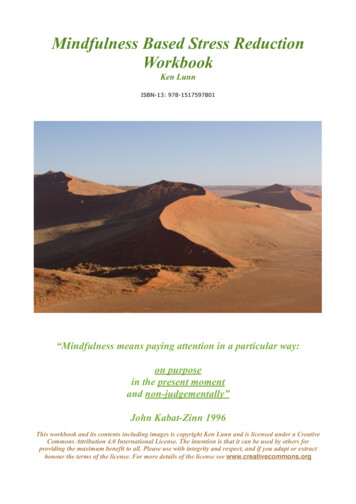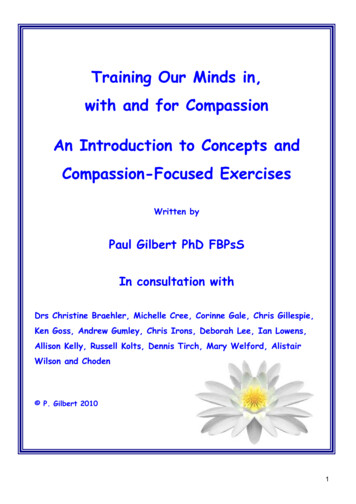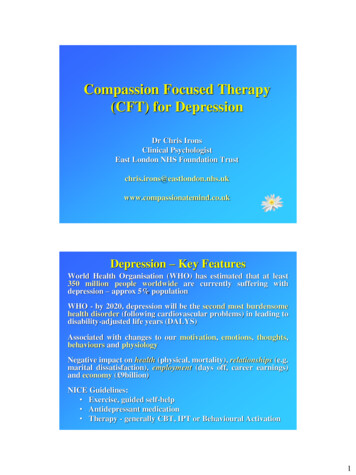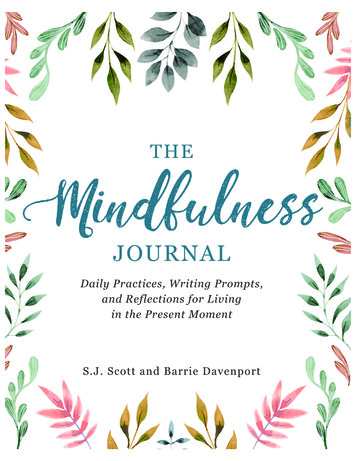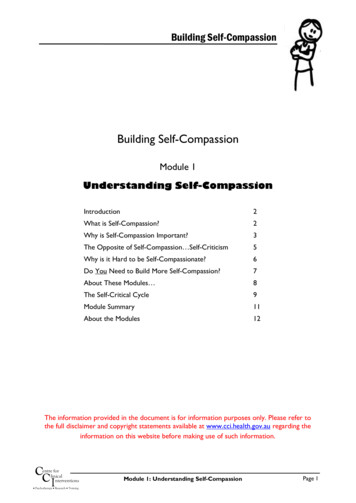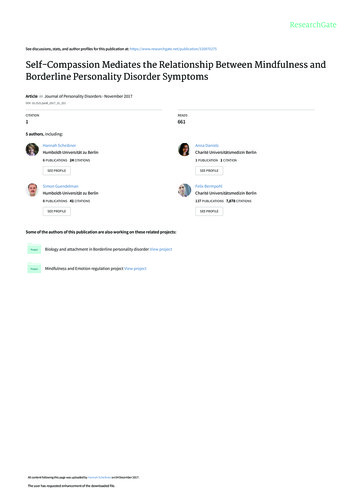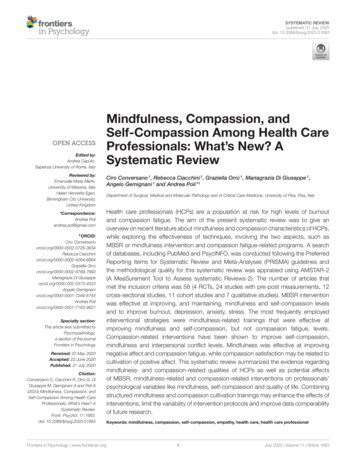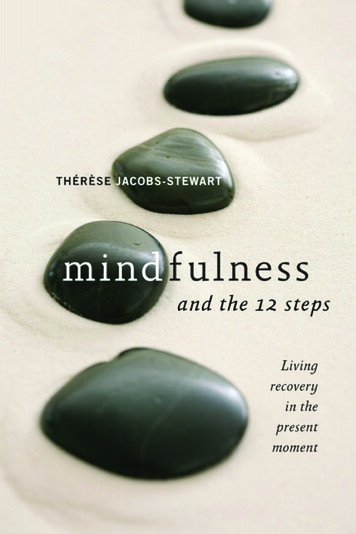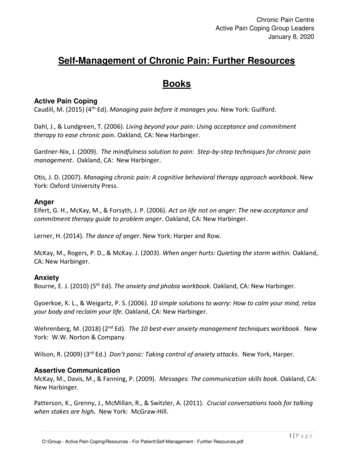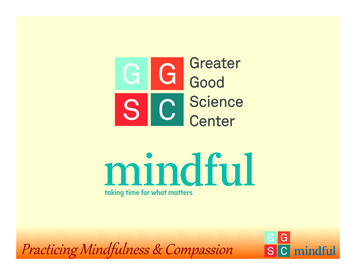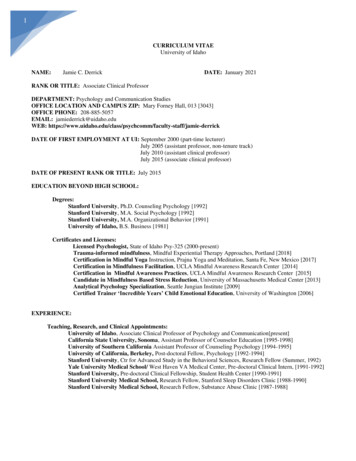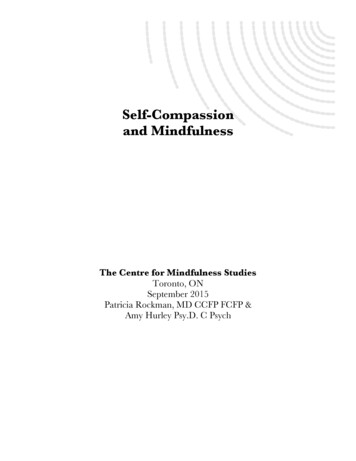
Transcription
Self-Compassionand MindfulnessThe Centre for Mindfulness StudiesToronto, ONSeptember 2015Patricia Rockman, MD CCFP FCFP &Amy Hurley Psy.D. C Psych
Self-Compassion & Mindfulness Program OutlineSession IDiscovering Self-CompassionIntroduction: Why are you here?Exercise: How would you treat a friend?Concepts and Research on Self-CompassionInformal Practice: Soothing TouchInformal Practice: Self-Compassion BreakExercise: Self-Compassion LanguageSession IIPracticing MindfulnessMeditation: Compassionate Body ScanDefault Mode NetworkThree Meditation SkillsMeditation: Affectionate BreathingMeditation: Pleasure WalkHere-and-Now StoneHomework Assignment(s)Session IIIPracticing Loving-Kindness MeditationMeditation: Compassionate Body ScanHomework ReviewMeditation: Affectionate BreathingMeditation: Loving Kindness Toward a BenefactorExercise: What Do I Need?BackdraftExercise: Freedom from BlameHomework Assignment(s)
Session IVFinding Your Compassionate VoiceMeditation: Loving –Kindness toward a BenefactorHomework ReviewMeditation: Extending Loving-Kindness toward OurselvesSelf-Criticism as a Safety BehaviourExercise: Finding our Compassionate VoiceManaging Compassion FatigueInformal Practice: Equanimity PhrasesInformal Practice: Compassionate Letter to MyselfHomework Assignment(s)Session VLiving DeeplyMeditation: Loving-Kindness toward Benefactor and SelfHomework ReviewMeditation: Centering MeditationCore ValuesExercise: Discovering Core ValuesMindful Movement PracticeExercise: Making a VowExercise: Silver LiningsHomework Assignment(s)Session VIManaging Difficult EmotionsMeditation: Centering MeditationHomework ReviewLabeling EmotionsMindfulness of Emotions in the BodyExercise: Soften, Soothe, AllowExercise: Working with ShameMeditation: Loving-Kindness toward Difficult PersonInformal Practice: Soften, Soothe, Allow in Daily LifeHomework Assignment(s)
Session VIITransforming RelationshipsMeditation: Loving-Kindness toward Difficult PersonHomework ReviewMeditation: Compassionate FriendSelf-Compassion in RelationshipsExercise: Letting Go of ResentmentInformal Practice: Time-OutExercise: Soft Feelings Behind Hard FeelingsInformal Practice: Forgiveness of Self and OtherHome Practice: What Works for Me?Homework Assignment(s)Session VIIIEmbracing Your LifeMeditation: Loving-Kindness for All BeingsKeys to Maintaining a PracticeCultivating HappinessExercise: Mindful EatingSelf-AppreciationExercise: Appreciating YourselfClosing: What Will You Take Home with YouCompassion Bowl
Session I: Discovering Self-CompassionOrientation1. How would you like to be treated during this program?2. How would you like to treat others?Exercise: How Would You Treat a Friend?1. How do you respond to a friend when they are struggling? What do you say?What do you do? What is your tone?2. How do you treat yourself when you are struggling? What do you say? What doyou do? What is your tone?Home Practice1. Notice how you speak to yourself throughout the day. What language do you use?2. Practice “Soothing Touch” twice daily.3. Use the “Self-Compassion Break” when you become aware of distress.
Session II: Practicing MindfulnessHome Practice1. Sitting practice (approximately 20 minutes), using three meditation “skills” – onpurpose, in the present moment and non-judgmentally2. Affectionate breathing practice3. Daily practice: compassionate movement4. Practice using the here-and-now stone when aware of distress5. Mindful Activity: Practice brining greater awareness to one daily activity each day(i.e. brushing teeth).
Session III: Practicing Loving-Kindness MeditationHome Practice1. Daily Practice: Loving-Kindness toward a benefactor.2. Notice situations where there is criticism toward yourself or another. See if youcan “soften” this criticism. What do you need to hear? Do?3. Practice using your own phrases when distress arises.
Exercise: What Do I Need?(Adapted from Dr. Tara Brach)1. Bring to mind some difficulty you are experiencing in your life currently. Sit for afew moments and play the situation out in your mind.2. Focus your awareness on any thoughts, feelings, sensations or emotions that arise.Ask yourself, what am I experiencing right now?3. Allow the thoughts, feelings, emotions or sensations to be there. Notice anyaversive reactions.4. Investigate your experience with a gentle curiosity. Ask yourself, “what mostwants my attention?” “How am I experiencing this in my body?” “What am Ibelieving?” “What does this feeling want from me?”5. Expand your awareness to the entire body.
Exercise: Freedom From Blame(Adapted from Dr. Kristin Neff)Think about a trait you often judge yourself for, and that is an important part of your selfdefinition.Ask yourself the following questions:1. How often do I display this trait? Who are you when you don’t display this trait?Are you still you?2. Are there particular circumstances that seem to draw out the trait, and others inwhich the trait is not apparent? Does this trait really define you if particularcircumstances must be present in order for it to emerge?3. What are the various causes and conditions that led to having the trait in the firstplace (early experiences, genetics, life pressures etc.)4. Did you choose to have this trait, and do you have much choice about whether ornot you display this trait? If not, why are you judging yourself for this trait?5. What happens when you reframe your self-description so that you are notdefining yourself in terms of this trait?
Session IV: Finding Your Compassionate VoiceHome Practice1. Daily Practice: Loving-Kindness toward a benefactor and self2. Daily Practice: Equanimity Phrases
Session V: Living DeeplyHome Practice1. Daily centering meditation2. Daily meditation practice of Loving-Kindness toward benefactor and self3. Each day, engage in one activity/behavior which engages your vow
Exercise: Discovering Core Values(adapted from Dr. Stephen Hayes)Imagine you are at your own funeral and someone is delivering your eulogy. Theycapture what you life has stood for and the person you were .What would you want that person to say?Is there some way in which you aren’t living in accord with your core values?Are there external circumstances that prevent you from living according to your corevalues?Are there internal circumstances that are preventing you from living according to yourcore values?Is there any way that giving yourself more compassion/support could help you live moreaccording to your values?
Making a VowIn your own words, write out a promise, you make to yourself that describes how you willlive according to your core values. For example, “may I be patient with myself when Imake mistakes”
Exercise: Finding the Silver LiningDescribe a past incident that seemed impossible at the time it occurred and that now youfeel you learned important lessons from.Describe, if there is one, a current situation (practical or emotional) that also seemsimpossible or you can’t see your way through.Assuming you’ll get through this, what could you learn from the current situation? Whatdeeper understanding will you have once you have gotten through the situation?Is there any way bringing greater self-compassion to the situation can help you learn andgrow?
Session VI: Managing Difficult EmotionsHome Practice1. Daily Loving-Kindness practice toward benefactor, self, neutral person andchallenging person.2. Daily Practice of Soften, Soothe, Allow.
3.
Exercise: Working with ShameThink of a behavior you feel very badly about (something you would like to changeand/or that you beat yourself up about).Write down what you regularly say to yourself about this behavior.Reflect on your mental chatter about this behavior and note the feelings that arise.Explore why you might criticize yourself. What is the critic trying to accomplish? Whatmight it be trying to do for you?If the critic had a function, what is it? Write down what the role of the self-critic has been.Let the critic know it has served you well, had good intentions and was trying its best tohelp you.Now close your eyes and imagine the behavior. Note what is happening in the body.Now, soften the body and offer yourself words of reassurance.
Session VII: Transforming RelationshipsHome Practice1. Continue practicing Loving-Kindness toward benefactor, self, neutral person anddifficult person.2. When uncertainty arises, practice the compassionate friend meditation.
Exercise: Letting Go of Resentment(Adapted from Jack Kornfield)1. Let yourself sit comfortably and quietly. Bring kind attention to your bodyand breath.2. Bring into awareness the story, the situation, the feelings and reactions thatit is time to let go of. Name them gently (i.e. anger, grief) and hold themcompassionately. Continue to breathe.3. Gently ask yourself, “Do I have to continue to replay this story?” “Do Ihave to hold onto these feelings?” “Is it time to let go?”4. If not, give yourself compassion for not being ready to let go.5. If you would like, say to yourself, “letting go, letting go”. Softly repeat thephrase.6. Soften the body and feel any space that arises as you let go.7. Sitting quietly notice if any of the feelings, thoughts, etc. return.8. Simply return to softening and the phrase: “letting go.”
Exercise: Soft Feelings Behind Hard Feelings1. Sitting quietly, reflect upon a recent situation in which you experiencedstrong feelings of anger and/or resentment.2. Notice what is happening in your mind and body. What do you feel? Whatstories are present?3. Now, sitting with the breath, see if you can relax and scan the body for anyadditional feelings. You might ask yourself, “is there anything I need that Iam not getting in this situation?”4. If not, try holding the hard feelings compassionately. If “softer feelings”(i.e. sadness or shame) arise, hold those compassionately as well. Noticewhat is happening in the mind and body.5. Gently ask yourself what you need now, in this moment. How might yougive yourself what you need?
Session VIII: Embracing Your LifeHome Practice
Meditation: Loving-Kindness for All BeingsOnce you have found a comfortable sitting position, spend a few momentsoffering loving-kindness toward a benefactor, yourself, a neutral person and adifficult person.Now, as best you can, expand your awareness to include individuals and groupswho are, in many ways, unknown to you. For example, you may wish for allwomen, or men, to be happy. It sometimes helps to categorize people, or beings,into opposites. For example, may all children be happy and may all adults behappy. Alternatively, you may simply wish for all beings to be happy.As you extend loving-kindness toward all beings, notice the spaciousness in thebody and see if you can notice your breath extending out, past the body.
Exercise: Appreciating Yourself(Adapted from Dr. Kristin Neff)List ten things about yourself that you really like or appreciate. The qualities youlist don’t have to be ones you display all the time. As you write down each quality,see if you can notice any uncomfortable feelings – embarrassment, fear of vanity,unfamiliarity? If discomfort comes up, remind yourself that you are not claimingyou’re better than anyone else, nor that you’re perfect. You’re simply noting thegood qualities that you sometimes display. See if you can acknowledge and enjoythe positive qualities you have, lingering over them and really taking them in.1.2.3.4.5.6.7.8.9.10.
Exercise: Seeing Yourself as You AreA. List five culturally valued traits for which you are above average12345B. List five culturally valued traits for which you are average12345C. List five culturally valued traits for which you are below average12345D. Consider the full range of traits listed above. Can you accept all these facets ofyourself? Being human does not mean being better than others. Being humanmeans you encompass the full range of human experience, the positive, thenegative and the neutral. Being human means you are average in many ways.Can you celebrate the experience of being human?
Self-Compassion and Mindfulness The Centre for Mindfulness Studies Toronto, ON September 2015 Patri
